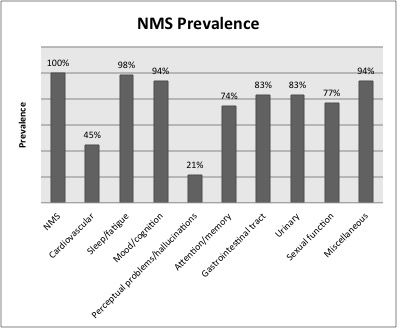Session Information
Date: Monday, June 20, 2016
Session Title: Parkinson's disease: Non-motor symptoms
Session Time: 12:30pm-2:00pm
Location: Exhibit Hall located in Hall B, Level 2
Objective: To evaluate the prevalence and severity of non motor symptoms(NMS) in Parkinson’s disease(PD) patients referred to a Deep Brain Stimulation(DBS) center.
Background: NMS are described in all stages of disease and encompass a wide range of symptoms. They significantly compromise the quality of life of PD patients. The DBS is a well recognized treatment for motor symptoms of PD, although its effects on NMS are still poorly studied. The lack of knowledge about the occurrence of NMS on patients submitted to DBS implantation also contributes for the paucity of information.
Methods: We prospectively included 47 patients with idiopathic PD referred for DBS treatment. The evaluation consisted of clinical interview and Levodopa challenge test. The motor impairment was assessed by UPDRS-III and Hoehn&Yahr. The NMS were evaluated with the UPDRS-I and the Non Motor Symptoms Scale (NMSS), that scores the severity and frequency of each symptom and clusters them into nine domains, cardiovascular, sleep/fatigue, mood/cognition, perceptual problems/hallucinations, attention/memory, gastrointestinal tract, urinary, sexual function, miscellaneous(pain, smell, weight, sweating). Quality of life was assessed in 26 patients using PDQ-39. Besides the descriptive data, we performed correlation study using Spearman coefficient.
Results: 27 male and 20 female PD patients were included, with mean age of 56±10,82 years and 12,4±3,67 years of disease. The mean Hoehn&Yahr OFFmed was 2,9±0,83.
| MEAN±SD | |
| AGE | 56±10,82 |
| AGE OF ONSET | 46,7±10,32 |
| DISEASE DURATION | 12,4±3,67 |
| LEVODOPA EQUIVALENT DOSE | 1283,9±468,13 |
| UPDRS I | 3,7±1,87 |
| UPDRS III OFFmed | 41,8±8,17 |
| UPDRS III ONmed | 13±7,48 |
| HOEHN&YAHR OFFmed | 2,9±0,83 |
| HOEHN&YAHR ONmed | 2,37±0,61 |
| NMSS TOTAL SCORE | 70,6±33,50 |
| PDQ-39 | 42,2±17,7 |
 Among the patients, 85,10% had severe or very severe NMS(NMSS ≥41). There was correlation between NMSS and PDQ-39 (rho=0,493, p=0,011). The duration of disease was negatively correlated to NMSS (rho=-0,384, p=0,008) and to mood/cognition (rho=-0,460, p=0,001). There was a strong correlation between NMSS and UPDRS part I (rho=0,616, p<0,001). The UPDRS part I was also correlated with mood/cognition, perceptual problems/hallucinations, attention/memory, sexual function and miscellaneous.
Among the patients, 85,10% had severe or very severe NMS(NMSS ≥41). There was correlation between NMSS and PDQ-39 (rho=0,493, p=0,011). The duration of disease was negatively correlated to NMSS (rho=-0,384, p=0,008) and to mood/cognition (rho=-0,460, p=0,001). There was a strong correlation between NMSS and UPDRS part I (rho=0,616, p<0,001). The UPDRS part I was also correlated with mood/cognition, perceptual problems/hallucinations, attention/memory, sexual function and miscellaneous.
| UPDRS PART I | ||
| rho | p-value | |
| NMSS TOTAL SCORE | 0,616 | [lang]0,001* |
| CARDIOVASCULAR | 0,268 | 0,069 |
| SLEEP/FATIGUE | 0,269 | 0,068 |
| MOOD/COGNITION | 0,557 | [lang]0,001* |
| PERCEPTUAL PROBLEMS/HALLUCINATIONS | 0,340 | 0,019* |
| ATTENTION/MEMORY | 0,359 | 0,013* |
| GASTROINTESTINAL TRACT | 0,042 | 0,781 |
| URINARY | 0,139 | 0,352 |
| SEXUAL FUNCTION | 0,300 | 0,041* |
| MISCELLANEOUS | 0,398 | 0,006* |
Conclusions: All the patients reported the occurrence of NMS and the majority of our sample had severe or very severe symptoms. The NMS correlated to worse quality of life. We suggest that the assessment of NMS should be included in the routine preoperative DBS evaluation, not only to improve our understanding on the effects of stimulation, but also to enhance patient’s quality of life.
To cite this abstract in AMA style:
M.G. dos Santos Ghilardi, R.C.R. Martinez, R.G. Cury, J.R. Aranha, M.J. Teixeira, E.R. Barbosa, E.T. Fonoff. Non-motor symptoms in PD candidates for DBS treatment [abstract]. Mov Disord. 2016; 31 (suppl 2). https://www.mdsabstracts.org/abstract/non-motor-symptoms-in-pd-candidates-for-dbs-treatment/. Accessed December 30, 2025.« Back to 2016 International Congress
MDS Abstracts - https://www.mdsabstracts.org/abstract/non-motor-symptoms-in-pd-candidates-for-dbs-treatment/
